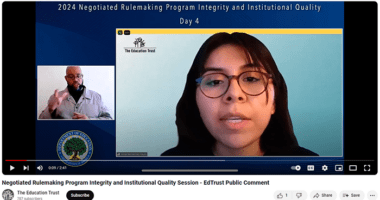Hey Richie Rich, How About Making College Cheaper?
UPDATED
Cha-ching! According to a new study, higher education endowment investment returns averaged an 11.7 percent gain in fiscal year 2013 compared with a decrease of 0.3 percent the previous year. There are now some 82 colleges and universities with endowments in excess of $1 billion each.
The wealthiest institutions of higher education — the 82 with over $1 billion in endowment assets each — spent out an average of only 4.8 percent of their endowments last year. That’s low given that all other foundations are required to spend out 5 percent as a condition of retaining tax-exempt status and many spend far more. Higher ed gets an exception. A difference of 0.2 percent may not sound like much, but if just the richest 82 institutions of higher education spent out 5 percent of their endowments last year, hundreds of millions more in student financial aid could have been made available — without costing taxpayers a penny. Think about how many lives could be changed.
Let’s look at a few examples:
The University of Notre Dame has an endowment of $6.9 billion but only spent out 4 percent of its endowment in 2012. With low enrollment of Pell Grant recipients (only 12 percent among freshmen) and an out-of-pocket net price equal to $11,939, it’s easy to see that Notre Dame could be doing more for students. By increasing their spend-out rate to 5 percent, Notre Dame could provide more than 5,000 students with a debt-free college education. That’s over half of their undergraduate enrollment. Presumably they could also use funds to do a better job on low-income student recruitment and no longer rank in the bottom 5 percent of colleges nationally on economic diversity. For shame.
Or there’s the University of Southern California that has a slightly smaller endowment of $3.9 billion and a spend-out rate of 4.4 percent in 2013. While USC already does a decent job of enrolling low-income students — 18 percent of the freshmen class are Pell Grant recipients — at least as compared with Notre Dame, they charge an average out-of-pocket, net price of $15,610 to students from low-income families. USC could provide more than 1,400 students with a debt-free education by increasing their spend-out rate by just 0.6 percent.
But our favorite is the University of Washington, one of the nation’s wealthiest public universities. When President Obama challenged colleges to slow the growth in tuition, the University of Washington’s President Michael Young called it “political theater of the worst sort.” Well, maybe President Obama should take a trip to Washington state and shine the theater’s spotlight there. The University of Washington holds $2.3 billion in endowment assets and had a spend-out rate of 4 percent in 2013. When families needed help most at the depths of the recession, the university cut its endowment spend-out rate by 40 percent (from 5 percent to just over 3 percent). They said they’d return to prior levels when capital market returns came back.
Guess what? The market has returned, and Michael Young’s university barely has opened the lockbox. The University of Washington, with 24 percent Pell Grant recipients in the freshman class, has an average net price for low-income students of $6,128. By increasing their spend-out rate from 4 percent to 5 percent, they could provide more than 3,800 students each the opportunity to attend UW debt-free; that’s about half of all their Pell Grant students.
Many Fighting Irish, Trojans, or Huskies may say their colleges’ hands are tied; that they are responsible not only for the needs of today’s university, but also tomorrow’s. They’ll say their endowment funds are restricted and that financial aid is a much harder philanthropic cause to raise money for than capital projects, like a brand new squash court. But we’ve seen that when the pressure is on, institutions step up.
In 2008, when there was talk of creating a minimum endowment payout rate, many of the wealthiest institutions of higher education raised their spend-out rates and devoted increased resources to student financial aid. More recently, in the wake of a grassroots campaign criticizing cutbacks in its financial aid program, the University of Virginia actively raised money for and announced an $8 million infusion of philanthropic support into grant aid for needy students.
Colleges and universities are not passive actors when it comes to what they get donations for, how the money is invested, and who benefits. Regular people expect colleges, especially wealthy colleges, to take access and affordability seriously, and in particular, if they’re not serving students from low-income families, to do something about it.
If the super wealthy colleges dismiss the concerns of hard-pressed families and don’t act on their own, watch out. At the very least, Sen. Charles Grassley on the U.S. Senate Finance Committee (or others) just might want to write a new playbill and script.
Research assistance for this post provided by Meredith Welch.
This post was updated to more accurately summarize the amount of student financial aid that could be made available if the richest higher education institutions spent out 5 percent of their endowments.
Photo credit: savagehenrymagazine.com












